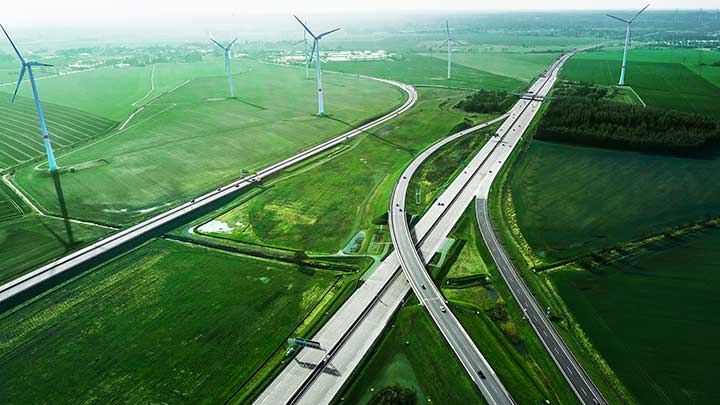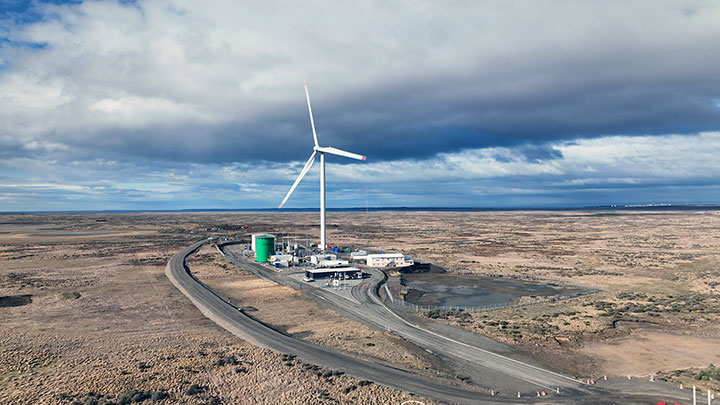Avoiding CO2-emissions
Decarbonization is the process of reducing the net output of carbon dioxide (CO2) into the Earth's atmosphere.
How can decarbonization be achieved?
A lower CO2 output can be achieved by eliminating technologies and energy sources that cause a lot of CO2 emissions, replacing them with low-carbon and zero-carbon alternatives, and by reducing energy requirements. At the same time, emissions can also be offset by by carbon sequestration or storage.
What is the goal of decarbonization?
The ultimate target is to achieve carbon neutrality, meaning a return to levels of CO2 naturally present in the atmosphere prior to human intervention.
How is MAN Energy Solutions contributing to decarbonization?
MAN Energy Solutions strives to be an active part of a global energy transition, opening up an economic, cost-effective and efficient pathway towards sustainable development. Our goal is a low-carbon economy and – in the long term – a net-zero future. Our forward-looking technologies for the power sector and maritime sector can help reduce their carbon footprints and increase their energy efficiency significantly.
Learn more about decarbonizationPower-to-X
A future technology for efficient and economic decarbonization
The world needs quick and efficient solutions to reach carbon neutrality by 2050. A vital part of those solutions will be green hydrogen and synthetic fuels derived from renewable energy using Power-to-X technology. Experts see hydrogen and Power-to-X
as key technologies towards decarbonization and predict massive cost efficiencies once facilities on an industrial scale are established.
We shouldn't talk about solutions available in a decade or so, but act now to reduce our carbon footprint. Power-to-X is one of the technologies we have today that can lead to immediate carbon reductions.
Future fuels to decarbonize shipping
Unlike road transport, where direct battery electrification is becoming the technology of choice, decarbonization in shipping can only happen by decarbonizing the fuels used in internal combustion engines. In particular, large ocean-going vessels cannot be electrified with batteries or fuel cells. This is why MAN Energy Solutions is convinced that large combustion engines will continue to power ships in the future – especially when it comes to long-distance shipping. Such fuels include LNG, LPG and ethane as well as alternative fuels like green ammonia, methanol, synthetic methane, and green hydrogen.
Learn more about the climate-neutral fuels of the futureExplore more
-

Carbon capture utilization storage
Carbon capture, utilization and storage will become more important for the energy transition as unavoidable emissions move to the forefront of discussions.
-

Decarbonization
MAN Energy Solutions powers decarbonization by helping customers to increase the efficiency of their plants and applications, and to reduce emissions.
-

Decarbonization
MAN Energy Solutions support their clients in the petrochemical and oil and gas industries in cutting emissions, saving costs and preparing for a carbon-neutral future.
-

Decarbonization
Our innovative solutions can help you reduce carbon emissions while generating profitable, reliable power.
-

Future fuels
No matter what vessel you operate, our proven, fuel-flexible engines and propulsion systems enable you to safeguard your future fuel strategy and allow you to take advantage of favorable market conditions.
-

Haru Oni e-fuels
The Haru Oni demonstration plant could pave the way for a viable alternative to fossil fuels: It produces synthetic e-fuels from hydrogen that can help the fight against climate change. MAN Energy Solutions provided the e-methanol reactor to the plant.
MAN Energy Solutions is now Everllence.
We have adopted a new brand name and moved to a new domain: www.everllence.com. This page will also be relocated there shortly. We are working on shifting all pages to www.everllence.com.
